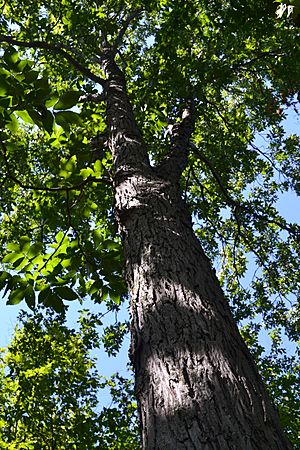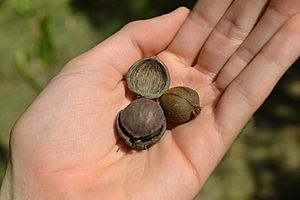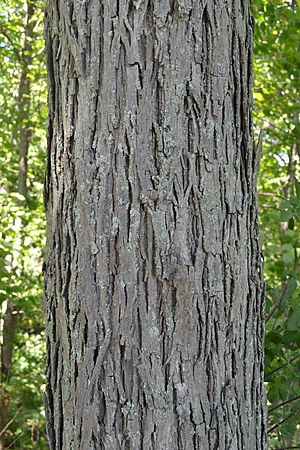Red hickory facts for kids
Quick facts for kids Red hickory |
|
|---|---|
 |
|
| Conservation status | |
| Scientific classification | |
| Genus: |
Carya
|
| Species: |
ovalis
|
The red hickory (also called sweet pignut hickory) is a type of hickory tree. It grows in eastern North America. You can find it from southern Ontario, Canada, down to northern Florida. It also grows west to eastern Texas and north-west to Nebraska. This tree likes dry, sandy hills and sloped woodlands. Scientists used to think it was a type of pignut hickory. But now, most agree it is its own special tree. They look quite different from each other.
Contents
What Does the Red Hickory Look Like?
The red hickory is usually a medium-sized tree. It can grow up to 30 m (100 ft) tall. It often has one straight main trunk. This trunk can go all the way up the tree. Sometimes, it splits into big branches at the top.
Branches and Shape
The branches are strong and long. The ones at the top grow upwards. The lower branches hang down. The middle branches grow straight out. This makes the tree look wide and thick. It has a column shape and gives lots of shade. Some red hickory trees can live for 100 to 250 years!
Leaves of the Red Hickory
The leaves of the red hickory are special. They are compound, meaning they have several smaller leaflets. Each leaf usually has 5 to 9 leaflets. Seven leaflets are the most common. The leaflet at the very end is often the biggest. The ones closer to the stem are smaller.
The leaflets are widest in the middle or near the top. Their edges are finely serrated, like tiny saw teeth. The top of the leaves is dark green and smooth. The bottom is paler and has fine hairs. A cool thing about red hickory leaves is their stem. This stem, called the rachis, is often bright red or purple. This helps tell it apart from other hickory trees.
Red Hickory Bark
The bark of older red hickory trees is grey. It has tight, flat ridges that cross each other. These ridges can look like blocks or straps. Sometimes, the bark might peel off the trunk in strips. This is like what you see on shagbark and shellbark hickories. Younger trees that are growing fast are more likely to have peeling bark.
Nuts and Seeds
Like all hickory trees, the red hickory grows nuts. These nuts are round or slightly oval. They grow alone or in groups of 2 or 3. They hang from the ends of branches. When they are young, the nuts are covered in a thin, green husk. This husk has 4 clear lines, or seams.
When the nuts are ready (in late September to mid-October), the husk changes. It turns from green and soft to dark brown and brittle. The seams then split open from the bottom up. The husk might or might not fully separate from the nut. The nut inside is smooth and tan-colored. It has 4 shallow ridges where the seams were. The seed inside is very oily. Its taste can be bitter or a little sweet. The shell is thick, so it's hard to get the kernel out. Many animals love these nuts. This includes rodents, birds, raccoons, and wild turkeys.
Flowers and Reproduction
The flowers of the red hickory appear in spring. This is usually in early to late May, when the leaves are also growing. The male flowers are long, green, and hang down. They are not very noticeable. They grow where the leaf stem meets the twig.
The female flowers look a bit strange. They have a sticky green tuft coming out of a swollen base. These grow alone or in groups at the end of new twigs. They appear after the leaves start to open. All hickory trees are monoecious. This means they have both male and female flowers on the same tree. But they cannot fertilize themselves. They need pollen from another hickory tree.
Images for kids







